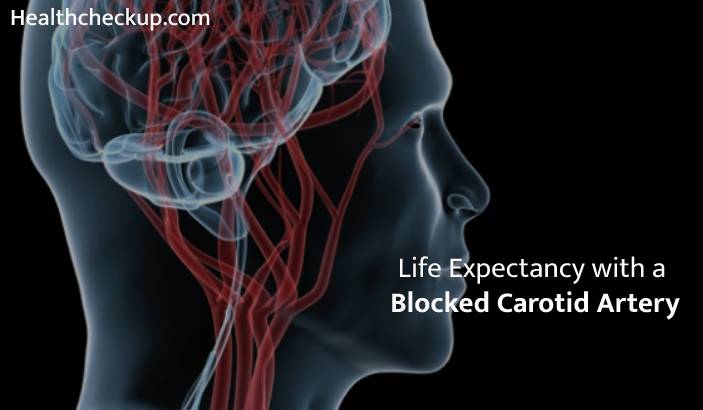Introduction
Carotid arteries are the blood vessels that supply blood to the brain and head and are present on both sides of the neck. Carotid artery disease is a medical condition in which the blood vessels that supply blood to the brain are blocked by the formation of plaque and fatty materials inside the blood vessels. Due to this blockage of the blood vessel, the supply of blood in the head and brain is reduced. As a result, there is a decreased oxygen level in the head. Eventually increasing the risk of stroke. Stroke decreases the amount of oxygen in the brain. After this, within a few minutes, the cells of the brain start to die. Also, stroke is the most common cause of permanent disability. It is important to understand how long can you live with a blocked carotid artery.
Life Expectancy And Prognosis Of Carotid Artery Disease
One hundred thirty-eight patients were studied with a follow up for about five years. The survival rate of patients aging 35 years or older was about 77%, whereas the survival rate of the healthy population was seen to be 85%.
The rate of stroke in the patients of age 35 or over was found to be 3%, out of which two-thirds were ipsilateral (on the same side). The stroke risk was eight times as compared to the other healthy population. The rate of stroke in younger patients was much higher than in older patients.
It was reported that adult male patients having a higher degree of stenosis in the carotid artery show a mortality rate of about 37%. It was based on the study done over a follow-up period of 4 years. However, the major risk of the increased mortality rate among the patients was co-morbidities like diabetes, claudication (decreased blood flow), and abnormal electrocardiographic results.
A higher risk of death was observed in patients with more than 2 or 3 risk factors. These patients require more aggressive treatment to cure the condition.
The main aim of the surgery is to reduce the chances of stroke in the patients. The chances of stroke are reduced to 11% after two years if the patient has undergone surgery.
Complications Of Carotid Artery Disease
The following complications can be observed in patients suffering from carotid artery disease. The main complication in case of the carotid artery disease is stroke. The stroke can be caused in the following ways:-
- The plague that ruptured: The plague may get ruptured, and these ruptured plaques may flow to the smaller blood vessels and can block them. Thus leading to blockage of blood flow and eventually stroke.
- By forming the blood clot: Some plague depositions are prone to cracks. Due to this cracking, they form an irregular surface on the lining of the blood vessels. The body senses this as an injury and sends blood cells to form a clot and stop bleeding. This clot formation at these sites may block the arteries, thereby reducing the blood supply to the brain and causing the stroke.
- Reduced flow of blood: The carotid artery may become narrow by the formation of the plague. It can become so narrow that the blood cells can get trapped in the blood vessels. It can lead to stroke.
What Are The Risk Factors For The Carotid Artery Disease?
- The older the age, the higher is the risk of developing carotid artery disease
- Males are more likely to develop carotid artery disease as compared to women
- Family history
- Race
- Genetic factor
- High cholesterol
- Being obese
- Smoking tobacco
- Increased blood pressure
- Not doing exercise
Conclusion
Carotid arteries are the important blood vessels that supply blood to the brain and scalp. These are present as external and internal blood vessels. External blood vessels supply blood to the scalp, face and neck, while the internal blood vessel supplies the blood to the brain. Patients have anxiety about their life expectancy with a blocked carotid artery after stroke. The chances of developing a stroke in the person suffering from it are around 35 to 40% if the surgery is not done. If the surgery has been performed, the risk of stroke in the patients reduces to about 11%.

Rohit Jain is an IPR Specialist and Medical Content Writing Expert. For over a decade, he has written several articles in the areas of female infertility, Erectile dysfunction, hemangioma, cervical cancer, monoclonal gammopathy of undetermined significance, mononucleosis, mitral valve disorder, nerve sheath tumor, shin splints, mild cognitive impairment, cellulitis, brain metastases, atelectasis, MCAD deficiency, lymphoma, sepsis, cardiac rehabilitation and metabolic disorder among others.








